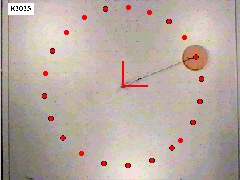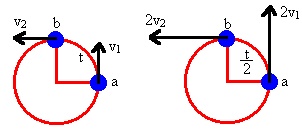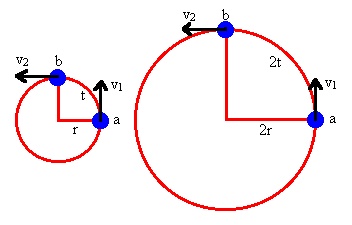
 |
Figure 1. A puck travels in a horizontal circle on an air table. |
Figure 1 shows a puck traveling in a horizontal circle on an air table. One end of a string is attached to a fixed point shown with the red angle in Figure 1. The other end of the string is attached to the puck. When set into motion, the puck travels in a circle with a radius equal to the length of the string. After marking the video you will see that the puck travels equal distances in equal times. This motion is called Uniform Circular Motion.
Uniform Circular Motion
An object undergoing uniform circular motion has these two observable characteristics:
Now, the puck travels equal distances in equal times, however, the direction of motion is continually changing. This means there is an acceleration. Recall the definition of net force:
Fnet = ma
Examining this equation, we see that an observed acceleration indicates there must be at least one force causing it. Also, the directions of the acceleration and the net force are the same since the mass is positive.
What force or forces can cause the acceleration in Figure 1? Remember that the motion is a horizontal circle, so both x and y are horizontal. The weight and normal are both perpendicular to the page and can not cause the observed acceleration (the weight is into the page and the normal is out of the page). Also, the air table reduces friction, so we will ignore it in this experiment. The only force that is left is tension. Recall that the direction of the tension is away from the object and along the string. Can you see that its direction will always be toward the center of the circle in this experiment?
We now know the direction of the acceleration. It must be in the same direction as the net force. In this experiment, the net force is the tension and its direction is always toward the center of the circle. So, the acceleration is also always toward the center of the circle. Now, what is the magnitude of the acceleration? How does it depend on the speed, v, and the radius, r?
Let's examine the relationship between acceleration and speed first. Figure 2 shows two diagrams of an object traveling in uniform circular motion. In the right diagram, the radius is the same but the speed has been doubled.
Look at the left diagram in Figure 2 first. The object is traveling counterclockwise and at point a its velocity is v1 up. At point b its velocity is v2 to the left. The time it takes to travel from a to b is t. We can write this acceleration as:
a1 = Dv/Dt = (v2 - v1)/t
Here v1 and v2 have the same speed, but their directions are different. So, their difference is not zero.

Looking at the right diagram, the speed has been doubled. At point a the velocity is 2v1 up and at point b the velocity is 2v2 to the left. The time it takes to travel from a to b is now t/2. This is true because the distance from a to b is the same, however the speed is doubled so the time is halved. We can write this acceleration as:
a2 = (2v2 - 2v1)/(t/2) = 2(v2 - v1)/(t/2) = 4(v2 - v1)/(t)
Or:
a2 = 4a1
So, doubling the speed did not double the acceleration, it increased it by four times. What would happen if we tripled the speed? Then at point a the velocity is 3v1 up and at point b the velocity is 3v2 to the left. The time it takes to travel from a to b is now t/3. Calling the acceleration for this case a3, see if you can show that:
a3 = 9a1
Try this example when the speed is quadrupled. You should see this pattern:
Therefore, in uniform circular motion, the acceleration depends on the speed squared.
Now lets examine the relationship between the acceleration and the radius. Figure 3 shows two diagrams. In the right diagram, the speed remains the same but the radius is doubled.
Look at the left diagram in Figure 3 first. The object is traveling counterclockwise and at point a, its velocity is v1 up. At point b, its velocity is v2 to the left. The time it takes to travel from a to b is t. We can write this acceleration as:
a1 = (v2 - v1)/t

Looking at the right diagram, the radius has been doubled. At point a the velocity is v1 up and at point b the velocity is v2 to the left. The time it takes to travel from a to b is now 2t. This is true because the distance from a to b is now twice as large, however the speed is the same so the time is doubled. We can write this acceleration as:
a2 = (v2 - v1)/(2t) = a1/2
So, doubling the radius halved the acceleration. What would happen if we tripled the radius? Then at point a the velocity is still v1 up and at point b the velocity is still v2 to the left. However, the time it takes to travel from a to b is now 3t since the distance is tripled. Calling the acceleration for this case a3, see if you can show that:
a3 = a1/3
Try this example when the speed is quadrupled. You should see this pattern:
Therefore, in uniform circular motion, the acceleration depends on the inverse of the radius.
This analysis shows that the acceleration for uniform circular motion depends on the speed squared and on the inverse of the radius. Therefore we can write:
ac = v2/r
Here the subscript, c, means centripetal (center seeking). Now we know that acceleration has dimensions of L/T2 so the above equation must have these dimensions. Does it?
Summarizing, we can say these things for uniform circular motion: